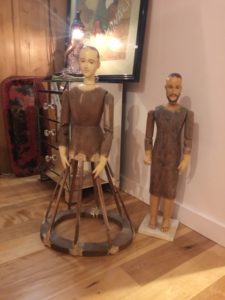 KC wrote me that she feels constricted during the Pandemic because she cannot frequent the thrift store where she purchased these two Bastidor sculptures. Now that she has the time, she asked me – WHAT are these ‘dolls?’ KC, they’re religious figures, and KC, you found quite fine ones. YES, I want to frequent that thrift store too, when the Pandemic ends!
KC wrote me that she feels constricted during the Pandemic because she cannot frequent the thrift store where she purchased these two Bastidor sculptures. Now that she has the time, she asked me – WHAT are these ‘dolls?’ KC, they’re religious figures, and KC, you found quite fine ones. YES, I want to frequent that thrift store too, when the Pandemic ends!
They stand quite tall at three feet for the Mary, and under three feet for the Joseph figure. These are Santos, religious icons found in the colonies of the Kingdom of Spain, and they represent the Holy Family and the Saints.
I find it unfortunate that many auction houses classify these as ‘folk art’, because they’re anything but. This tradition goes back to the 16th century. A tradition that tells the tale of the attempt to covert the indigenous people of the Philippines, Puerto Rico, the Caribbean, South and Central America, and importantly, for KC, New Mexico, and California, using such lifelike and accessible icons. Beguiling even today, they remind us that the saints were saints– but in human form.
Clothing the Bastidor sculptures
You see KC’s figures unclothed, and for a good reason. To clothe the figures is considered a duty and an honor. Devotees decorated the statues with expensive, gaudy clothing, and bright shining jewels, following Spanish tradition. Sometimes we find these figures used in a private chapel or altar, or venerated in churches. But KC’s figures appear too small to be ecclesiastical, used in a grand church, and must have been used for private veneration. I believe these date from the early 20th century.
KC, because yours are carved in 360 degrees, we call them revultos, or a bultos. Opposed to thos mounted in the back of an altarpiece in a grand church, carved in relief for a frontal view of 180 degrees.
Specifically, yours consists of a frame on which we adorn the figure with clothing, and THAT form is called a Bastidore. To accommodate the clothes, the arms need to articulate above the lattice cage, meant to hold a grand gown for the Mary figure, for example.
To attend and dress a Bastidor figure becomes a family honor and religious act. Just like we dress our children for a special day!
We call a craftsman who makes then a Santeros
I had the great pleasure of visiting a few great Santeros in New Mexico, a center for such art. 4th generation artists from New Mexico made these figures, and some are found in the Vatican.
I guess your figures originate from New Mexico because the wood they’re made from appears light. Their smaller scale means they’re not meant to be seen from the distant, like in a church, indicates an origin of New Mexico.
Once carved, the modeling of the features comes from a mixture of wood shavings mixed with a type of glue. The Santero then paints that coating, called gesso, to create the face and minor details.
If you want to dress such a figure traditionally, pay special attention to the head. On KC’s figures you see no painted hair, only a bald pate waiting for a suitable crown. Design a halo or crown of costume jewels, or if you have the means use real jewels to set off the head. We call the headdress a Resplendor. Traditionally, headdresses are made of punched tin or brass, or for the wealthy silver or gold, and set with precious jewels. Imagine how that shone in the candlelight at a home altar.
Look close to see the Joseph figure once held a staff (think St Christopher). By this the Santeros showed Joseph’s devotion.
If you owned one of these figures, and followed the Holy Day calendar, you might “process” it though the streets. Note that to do so, you need an appropriate carriage!
KC, the value of your two Bastidor Sculptures is $1,000. I think you did very well. Now consider dressing your Bastidors! Maybe that will get us out of this Pandemic faster?
Pingback: Lifelike Soulful Saint Francis Santos - Elizabeth Appraisals
Pingback: Religious Mosaics Equal Byzantine Wonders - Elizabeth Appraisals